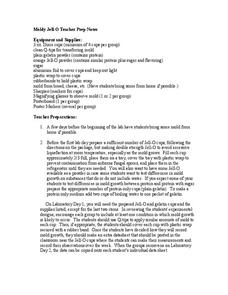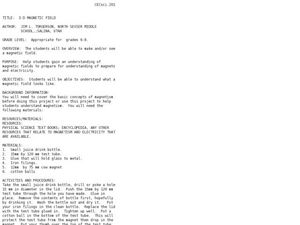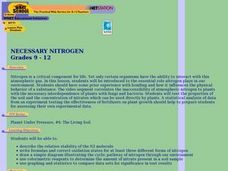Curated OER
Moldy Jell-O
Students design an experiment to determine the best conditions for molds growth. In this biology lesson, students collect data for a week and analyze their findings. They create a presentation and share them with the class.
Curated OER
Mineral Identification
Learners investigate the environment by examining mineral characteristics. In this mineral lesson, students perform scientific observations in groups in which they identify minerals found in everyday objects by using a worksheet. ...
Curated OER
Herbal Medicines
Students become critical thinkers about substances that are called medicines and it guides them into an inquiry process of carrying out their own investigations of the attributes of some common herbal remedies.
Curated OER
Glucose Factory
Fourth graders determine, through laboratory activity, the presence or absence of glucose in a variety of plant leaves and stems. They work in groups and perform a three part laboratory which shows them how plants convert sunlighht to food.
Curated OER
3-D Magnetic Field
Young scholars create a magnetic field. In this investigative lesson students design their own magnetic field so that they can see how magnetism and electricity work.
Curated OER
Oat Seed Lab: A Model Scientific Experiment
Young scholars investigate seed germination. In this lesson on scientific prediction, students conduct a scientific experiment using oat seeds.
Curated OER
The Synthesis of Some Organic Compounds And Their Representative Structures
Students examine how to represent organic compounds three-dimensionally. They write a synthesis reaction for three demonstrations, and construct a three-dimensional structure using a molecular modeling set.
Curated OER
Mineral Identification
Eighth graders examine the properties that are used to identify minerals and how they work. In this investigative lesson students use the six properties to identify minerals that they are given.
Curated OER
The Effects of Water Quality on the Growth Rate of Freshwater Mussels
Students participate in a field and laboratory study to determine if local freshwater mussels are environmentally stressed.
Curated OER
How Do We Generate a Large Amount of a Specific DNA Sample?
Students investigate the Polymerase Chain Reaction technique that is used to create larger amounts of a gene. They watch and discuss a PowerPoint presentation, explore a website, and write a report listing the materials needed to...
Curated OER
Generate a Calibration Curve for Chlorophyll a
High schoolers measure and graph the absorbance of light by chlorophyll at a specific wavelength versus chlorophyll concentration. They are given an unknown and determine its concentration from their calibration curve. Students become...
Curated OER
Food Chemistry: The Chemistry of Sweeteners
Students investigate the properties of sweeteners. For this chemical property lesson, students examine the unique properties of sweeteners by performing several experiments. They will analyze the data to form a conclusion about the...
Curated OER
Design Project: Voltmeter
In this physics worksheet, students design and build a multi-range voltmeter. They answer 3 short answer problems about the device.
Curated OER
Honey Bee Anatomy and Identification
Young scholars examine and dissect a worker honey bee to analyze the structures and functions of honey bees. They draw the structures they see and compare/contrast them to drawings or electron micrographs.
Curated OER
The Water Detectives
Pupils collect water samples from designated sampling stations, and discuss water pollution. They analyze the water samples, record the data on a spreadsheet, and present the environmental water quality data to the class.
Curated OER
Necessary Nitrogen
High schoolers view a video that presents the biogeochemical cycle of nitrogen. They compare types of soils and consider how different fertilizers affect soil composition.
Curated OER
Lead Detection
Students explore one method for the detection of lead in soil. The detection of the presence of lead in soil can be determined sensitively using inexpensive swabs. Pupils collect several spoonfuls of soil from various parts of their...
Curated OER
Down the Drain
Students explore what problems might occur if oxygen decreases in a body of water. They model what happens in a situation where decomposition is occurring. Students obtain, organize, graph, and interpret information. They i interpret...
Curated OER
Force/Newton's Laws/Friction
Students describe how to recognize a force, define balanced and net forces, state Newton's first law of motion, explain why friction works, state Newton's second Law of Motion, and explain why the direction of force is important.
Curated OER
PH Neutralization For Pollution Control
Learners recognize whether a solution is an acid or a base. In this acids and bases lesson plan, students use chemicals and identify if those chemicals are acids or bases. From the conclusion, learners will be able to identify if the...
Curated OER
Trees: Recorders of Climate Change
Middle schoolers study cross sections of trees or tree "cookies" to discover how the rings on tree sections give clues to the climate during the time the ring was produced. They study simulated cross sections of trees to determine the...
Curated OER
Forces And Motion
Eighth graders work together in order to investigate the concepts of force and motion. They conduct research using a variety of resources while taking notes. The notes are compiled in order to construct a notebook that is used for a...
Curated OER
Potato Lab
In this osmosis worksheet, students put a strip of potato in three different solutions and document the changes in the potato to determine is the solutions were hypotonic, hypertonic, or isotonic. This worksheet has 6 short answer...
Curated OER
Human Body Explorations
Students examine genetics and the DNA of a kiwi. In this DNA lesson students complete a lab to extract DNA and interpret their results.

























